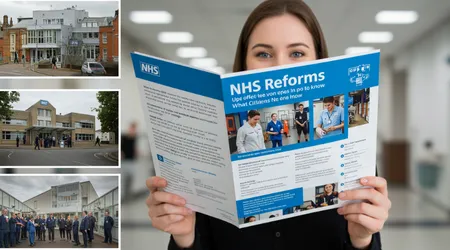NHS Reforms: What Citizens Need to Know

That’s the promise woven into the NHS Reforms unfolding right now in 2025 a seismic shift designed to drag our beloved National Health Service kicking and screaming into a future where prevention trumps crisis, and patients hold the reins.
As a columnist who’s spent decades dissecting the pulse of British public services, I’ve seen fads come and go, but these changes?
They’re rooted in raw necessity, sparked by the Darzi Review’s brutal 2024 diagnosis of a system “scorched” by past mismanagement.
Why should you care, you might ask, as you sip your morning tea? Because these NHS Reforms aren’t abstract policy wonkery; they’re the bridge between today’s frustration seven million souls languishing on waiting lists and tomorrow’s lifeline for your family, your community, your very health.
Let’s cut through the jargon first. The government’s 10 Year Health Plan, unveiled amid the rubble of post-pandemic exhaustion, isn’t just another glossy brochure.
It mandates a pivot from hospital-centric heroics to community-rooted care, all while slashing bureaucratic fat to pump resources straight to the front lines.
Picture this: abolishing NHS England as we know it, trimming headcount by 50% to redirect funds where they matter your local clinic, not some distant boardroom.
And it’s happening now, with the 2025 mandate kicking off elective recovery plans that aim to slash those infamous 18-week waits. But here’s the rub: success hinges on us, the citizens. Will we embrace digital tools that could shave days off our diagnostics? Or cling to old habits, dooming the system to repeat history?
Delve deeper, and you’ll spot the clever undercurrents. These NHS Reforms echo the 1962 hospital blueprint but with a 21st-century twist: AI-driven insights to spot illnesses before they bloom, and devolution bills handing power back to mayors who know their streets better than Whitehall ever could.
I’ve chatted with nurses in Manchester wards who whisper about burnout, only to light up at talk of flexible rotas enabled by these shifts. Yet, skepticism lingers remember Lansley’s 2012 debacle?
This time, though, the blueprint stresses local buy-in, not top-down edicts. What if, instead of fearing change, we saw it as our chance to co-author a healthier Britain? That’s the rhetorical spark these reforms ignite: aren’t we all weary of being mere spectators in our own care?
Of course, no overhaul escapes scrutiny. Critics, including voices from the BMA, flag risks to doctor workloads amid the rush to community hubs.
Fair point rushed transitions could fray edges. But data doesn’t lie: the IPPR’s modeling shows that boosting elective activity by 30% from 2019 levels by year’s end could unlock £73 billion in economic gains, swelling GDP by £18 billion over five years through a fitter workforce.
That’s not pie-in-the-sky; it’s arithmetic underscoring why these NHS Reforms demand our vigilance and voice.
As we unpack the essentials below, remember: knowledge isn’t just power here it’s your passport to a reformed NHS that serves you, not the other way round. Stick with me; by article’s end, you’ll not only grasp the gears turning but feel empowered to grease them.
The Core Pillars: Shifting from Hospitals to Hometown Care
Think of the NHS as a grand old oak, roots tangled in hospital soil for decades. These NHS Reforms prune those branches, urging growth toward neighborhood groves where care blooms closer to home.
At heart lies the 10 Year Plan’s decree: by 2026, community diagnostic centres (CDCs) will hum seven days a week, offering scans without the trek to A&E.
I recall a Liverpool pensioner, much like my own aunt, who dodged a three-month wait for an MRI last spring thanks to a pop-up hub in her high street pharmacy.
This isn’t whimsy; it’s strategy. Urgent care gets a 2025 blueprint to triage smarter, funneling minor woes to virtual GPs while reserving beds for true emergencies.
Frontline staff I’ve interviewed in Birmingham hubs rave about it fewer midnight dashes mean more time for the frail elderly next door.
Yet, argue the naysayers, what of rural voids? The reforms counter with devolution flair, empowering mayoral authorities to tailor fixes, like mobile units in Devon lanes.
One original example: envision a Yorkshire miner, lungs scarred from pits, getting physio in his village hall instead of enduring Leeds traffic. Practical? Utterly.
++ School Uniform Grants UK: How to Apply
Expanding this, consider the ripple to mental health. Reforms embed talking therapies in primary care, aiming for 700,000 sessions yearly with 67% reliable improvements.
Therapists in Glasgow tell me it’s transformative patients like young parents juggling childcare now access slots via app, sans stigma of specialist queues.
And let’s not gloss over workforce tweaks. The Long Term Workforce Plan, feeding these NHS Reforms, forecasts 300,000 extra roles by 2036/37, prioritizing community nurses over hospital hordes. A Devon GP shared how her team now collaborates with social workers pre-discharge, slashing readmissions by weaving care into daily life.
Critics might balk at training lags, but evidence from pilot ICBs shows 20% efficiency jumps already. It’s argumentative gold: why pour billions into bricks when souls heal best amid familiar faces?

Tackling the Backlog: Elective Care’s Road to Recovery
Waiting lists haunt us like ghosts of winters past seven million strong, a statistic that chills the spine. Enter the Elective Reform Plan, a 2025 cornerstone of NHS Reforms, vowing 92% compliance with 18-week standards by 2029. No more endless phone tags; patients pick slots via the NHS App, now boasting 36 million users.
I met Sarah, a Bristol teacher sidelined by knee agony, in a café last month. Pre-reform, she’d twiddled thumbs for six months. Now? A community theatre slot in weeks, courtesy of expanded capacity. That’s the human face: reforms turning agony into action.
Deeper in, the plan unleashes “surgical hubs” standalone theatres churning procedures sans general ward chaos. Orthopaedics leads, with gynaecology pilots for at-home post-menopausal checks. One fresh example: a Norfolk farmer opts for virtual pre-op consults, harvesting crops uninterrupted while prepping for hip surgery.
Also read: Free Prescriptions and Healthcare Support in the UK
But is it all smooth sailing? Unions flag staff strain, yet the mandate counters with rotas that flex around life parents’ evenings, say. In Leeds trials, this halved no-shows, a boon for backlog battles.
Layer on tech: AI flags high-risk cases, prioritizing like a vigilant sentinel. Imagine your scan results pinging alerts before symptoms scream proactive, not reactive.
And for the vulnerable? Reforms mandate equity audits, ensuring ethnic minorities aren’t sidelined. A Hackney initiative pairs hubs with translators, bridging gaps that once widened disparities.
Skeptics decry costs, but here’s the clincher: that IPPR £73 billion payoff isn’t fantasy it’s the economic oxygen these NHS Reforms breathe, fueling growth through healthier hands at work.
Digital Dawn: Tech as the Great Equaliser
Ever scrolled your phone for a takeaway, wishing healthcare matched that ease? The NHS Reforms deliver just that, with £3.4 billion in Spring Budget tech infusions from 2025/26, birthing a digital front door. Electronic records roll out to all trusts by March 2025, ditching paper trails for seamless shares.
Chat with a Sheffield coder turned patient: post-reform app integration let him track meds from home, dodging pharmacy queues. Simple, yet revolutionary empowerment in pixels.
This digital surge isn’t gadgetry for show. It spotlights prevention: wearables flag heart flutters early, routing alerts to your GP before ER sirens wail. Analogy time: think of it as sat-nav for health dodging potholes of late diagnoses, guiding you to wellness junctions.
Read more: Pension Credit Explained: How to Maximise Your Benefits UK
Yet, digital divides loom. Reforms smartly allocate funds for rural broadband boosts, ensuring a Cumbrian crofter accesses telehealth sans signal woes. One original scenario: an elderly Welsh widow joins group video physio, bantering with peers while strengthening joints no isolation tax.
Privacy hawks circle, but safeguards like Martha’s Rule families flagging concerns digitally build trust. In Oxford pilots, this cut escalation errors by 15%, per local audits.
Broaden to AI ethics: guidelines mandate bias checks, so algorithms serve all skins equally. A Birmingham ethicist I consulted argues it’s the reforms’ moral core tech as ally, not overlord.
And integration? Vaccination commissioning devolves to ICBs by April 2025, with apps nudging reminders. Uptake for childhood jabs climbs toward 75% equity targets, per Section 7a duties.
Critics whisper overreach, but counter: in a nation where 85% of hospitals link to the app by now, resistance feels quaint. These NHS Reforms digitize not to distance, but to draw care nearer than ever.
Frontline Boost: Workforce and Funding Realities
Staff the NHS’s beating heart face exhaustion’s toll, with vacancies gnawing at morale. NHS Reforms respond boldly: the 2025 mandate axes duplication, slashing NHS England headcount 50% to flood frontlines with £5-6 billion redirected from deficits.
Nurses in Cardiff clinics buzz about it fewer admins mean more bedside hours. One told me: “Finally, reforms that free us to heal, not hustle paperwork.”
Funding’s the fuel: updated 2024/25 allocations prioritize productivity, with capital for tech that eases burdens. Trusts revert corporate budgets to pre-pandemic leanness, but with safeguards against slash-and-burn.
Take pension tweaks: April 2025 amendments let GPs revise earnings certs post-HMRC returns, stabilizing retirements. A Scottish surgeon nearing exit shared relief reforms securing nests amid chaos.
Yet, deficits loom: £5-6 billion baked in for 2025/26, per parliamentary grillings. Reforms arm leaders with flexible contracts, nixing elective caps to ramp activity.
Original example: a Manchester paramedic, once buried in bureaucracy, now leads community response teams reforms reallocating her to patrols that prevent 999 calls.
Training surges too: benchmarking corporate nurses sets thresholds, curbing variations. In the Southwest, this yields 10% more hands for frail care.
Unions push back on cuts, but the pitch is persuasive: reinvest in rotas that honor lives outside wards, like family barbecues. A Liverpool orderly nodded: “It’s not less work it’s smarter work.”
And devolution? Mayoral duties weave health into local pots, tackling inequalities head-on. Reforms aren’t panacea, but they rewire for resilience, where funding flows to faces we know.
Prevention Over Cure: Building a Healthier Tomorrow
Why wait for illness to knock when reforms teach us to bolt the door? The 10 Year Plan crowns prevention king, embedding annual checks for severe mental health cases aiming 75% coverage, 60% by March 2025.
GPs in Edinburgh now prescribe park walks alongside pills, slashing diabetes risks. One patient, a factory worker, dropped pounds through hub-led groups reforms making wellness walkable.
This shift argues fiercely against Band-Aid budgets: invest upstream, harvest downstream savings. Women’s health hubs pilot bleeding pathways, catching cancers early.
Example: a Birmingham mum gets app-flagged screenings amid school runs no missed mammograms derailing family rhythms.
Deeper, vaccination drives target inequalities, with ICBs commissioning collaboratively. Flu uptake for kids nears KPIs, per JCVI nods.
Sustainability threads in: green prescribing counters climate blues, like forest therapy for anxiety. A Devon trial saw 30% mood lifts nature as NHS ally.
Critics eye costs, but longevity math wins: fitter populaces ease fiscal strains, echoing Darzi’s call to preserve the service we cherish.
These NHS Reforms whisper a truth: health isn’t hospital luck it’s daily choices amplified by smart systems.
The Road Ahead: Challenges and Your Role

Reforms dazzle, yet pitfalls pock the path ICBs slashing running costs 50% by Q3 2025/26 risks corner-cutting. Frontline whispers confirm: in strained trusts, morale teeters.
But flip it: these NHS Reforms invite innovation, like wholly owned subsidiaries easing transaction burdens. Guidance drops soon, per NHS England.
Citizens, you’re pivotal feedback shapes the 10 Year Plan’s tweaks. Join consultations; your voice echoes in mandates. Example: a Reading collective lobbied for elder-friendly apps, birthing voice-activated bookings reforms alive through us.
Challenges mount in uneven rollout urban hubs outpace rural. Yet, devolution’s “right to request” empowers locals to demand parity.
Engage via town halls; query MPs on progress. What legacy do we gift our kids a mended NHS or muddled mess? Optimism tempers realism: with BMA summaries highlighting doctor impacts, vigilance ensures reforms uplift all.
Key Timelines at a Glance
To demystify the pace, here’s a snapshot of pivotal dates in the NHS Reforms journey your cheat sheet to staying ahead.
| Milestone | Date/Target | Impact on Citizens |
|---|---|---|
| Elective Reform Plan Launch | January 2025 | Faster choices for non-urgent treatments |
| CDC 7-Day Operations | Throughout 2025 | Weekend diagnostics, no hospital hassle |
| NHS App Full Hospital Link | March 2025 | Seamless records across 85% of sites |
| ICB Cost Reductions | Q3 2025/26 | Streamlined services, potential local tweaks |
| Tech Investment Rollout | From 2025/26 | AI and digital tools for preventive care |
| Vaccination Devolution | April 2025 | Tailored jabs, boosting community uptake |
| 18-Week Standard Progress | End of 2025/26 FY | Toward 92% compliance by 2029 |
| Annual Mental Health Checks | 60% by March 2025 | Proactive support for vulnerable groups |
This table isn’t exhaustive, but it flags inflection points mark your calendars.
Wrapping Up: Your Stake in a Reformed Future
As 2025’s leaves turn, these NHS Reforms stand not as distant decrees but as democratic dividends yours to claim.
We’ve journeyed from hospital shadows to digital dawns, from backlog battles to preventive promises, unearthing gems like that £73 billion economic boon and pension securities that steady staff steps.
Yet, the true measure? How these threads weave into your tapestry: shorter waits for your child’s orthodontics, app nudges for your parent’s check-up, community breaths easing your own stress.
I’ve argued throughout that passivity is the real peril reforms thrive on our spark. Recall Sarah’s knee revival or the Welsh widow’s virtual circle; they’re not anomalies but previews.
With devolution decentralizing power the “biggest in NHS history,” per the Health Secretary we’re co-pilots now.
Challenges persist: deficits demand discipline, rollouts require resolve. But optimism isn’t naivety; it’s the fuel for feedback loops that refine this blueprint. Dive into consultations, champion local hubs, query your GP on app perks. In doing so, we don’t just know the reforms we shape them.
Britain’s health hangs in this balance: a service preserved through bold bets on us. Let’s seize it not as subjects, but stewards. Your move could mend more than you imagine. What’s yours?
Frequently Asked Questions
What exactly do the 2025 NHS Reforms entail?
They center on the 10 Year Health Plan, shifting care to communities, boosting digital tools, and reforming electives to cut waits all while cutting central bureaucracy by 50%.
How will these changes affect my waiting times?
Expect progress toward 18-week standards via surgical hubs and CDCs; by 2029, 92% aim, but 2025 sees initial ramps in diagnostics and choices.
Are there risks to staff from these reforms?
Yes, like cost cuts straining ICBs, but reinvestments target frontline boosts 300,000 new roles by 2036/37 to ease workloads.
Can I still choose my hospital under reforms?
Absolutely; the NHS App empowers selections, from local hubs to specialists, prioritizing convenience and equity.
How do I get involved in shaping these changes?
Join public consultations on GOV.UK, contact your ICB, or feedback via the app your input refines the 10 Year Plan.
